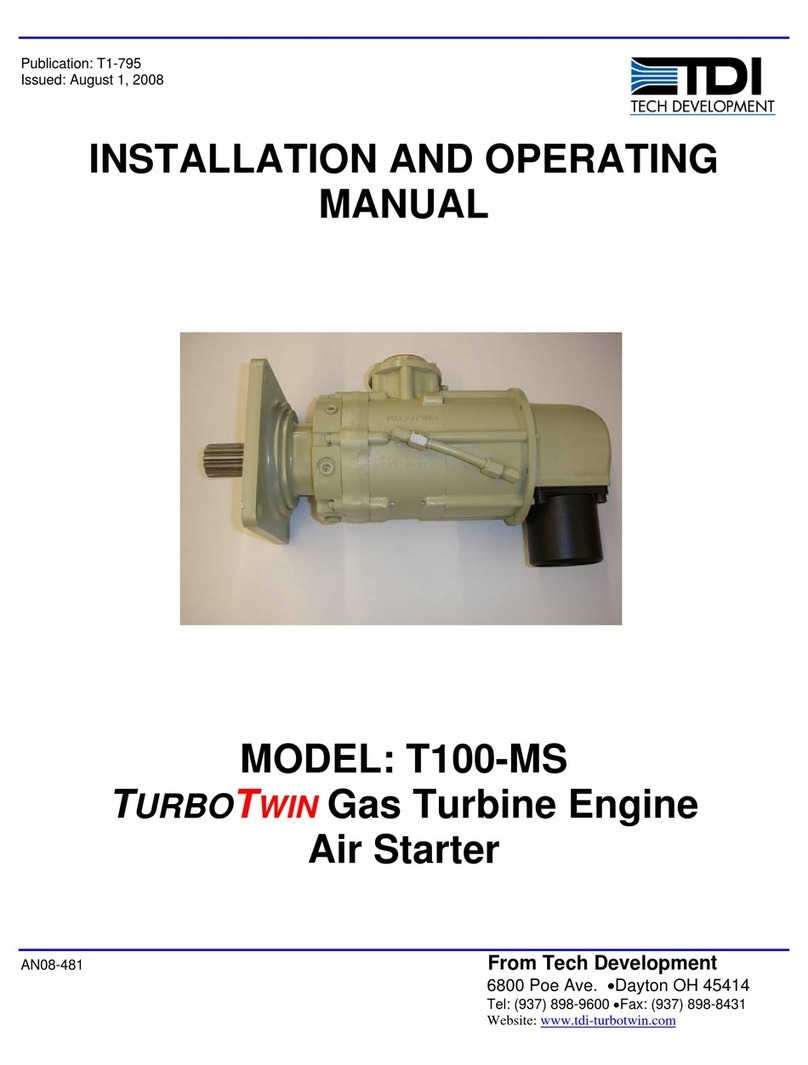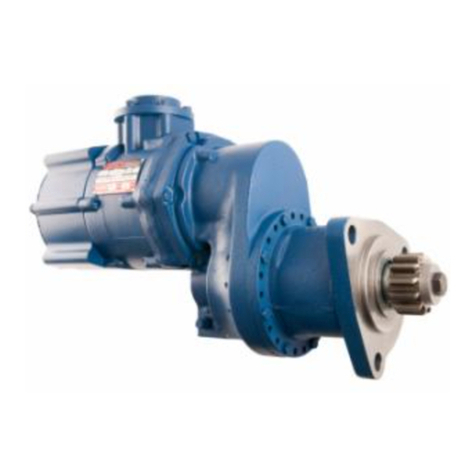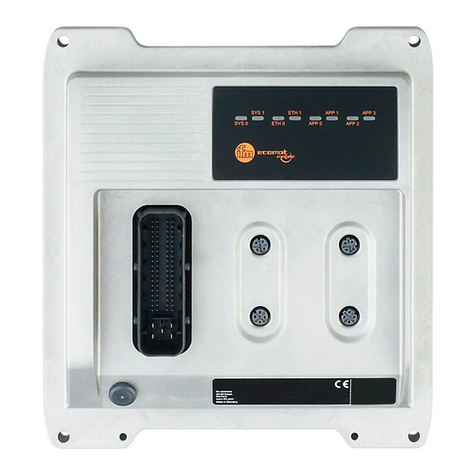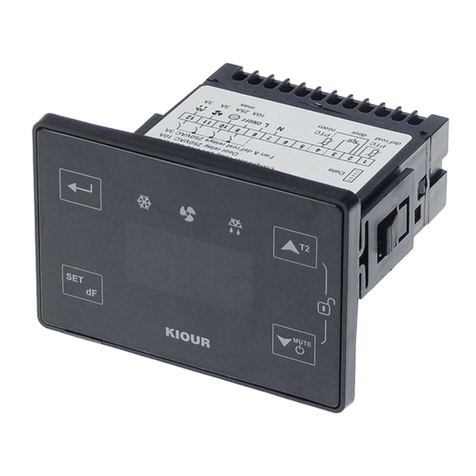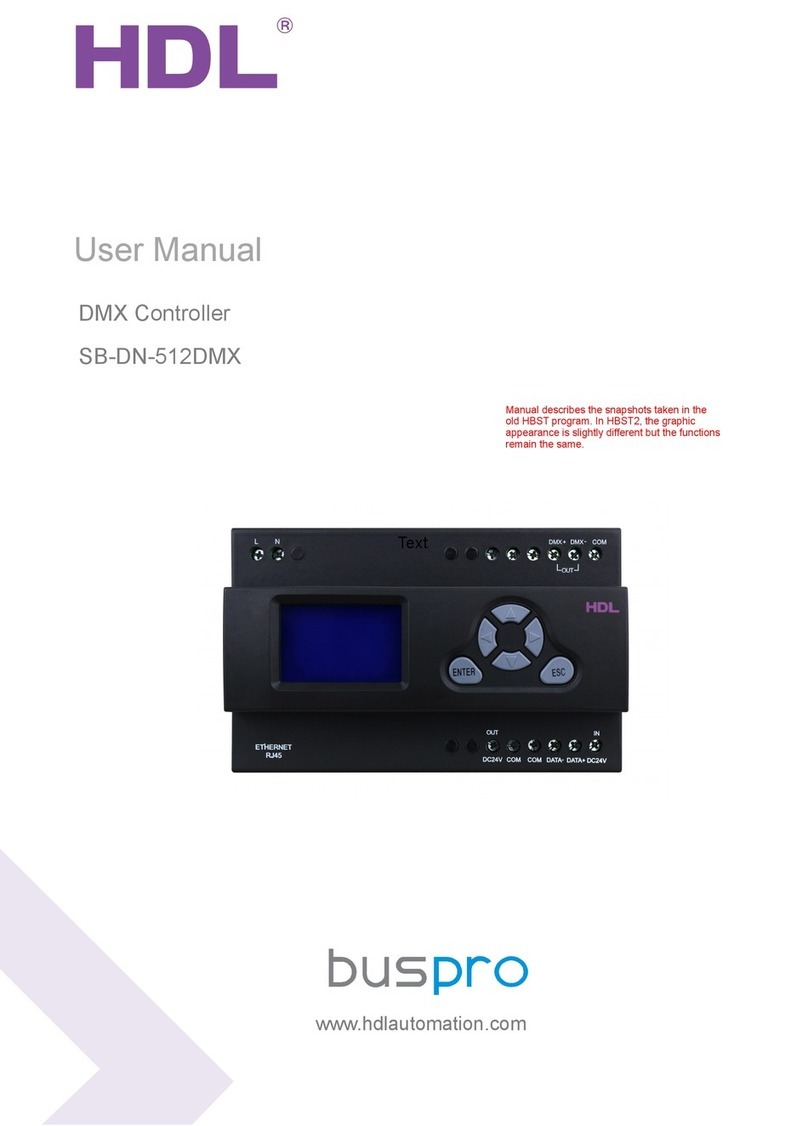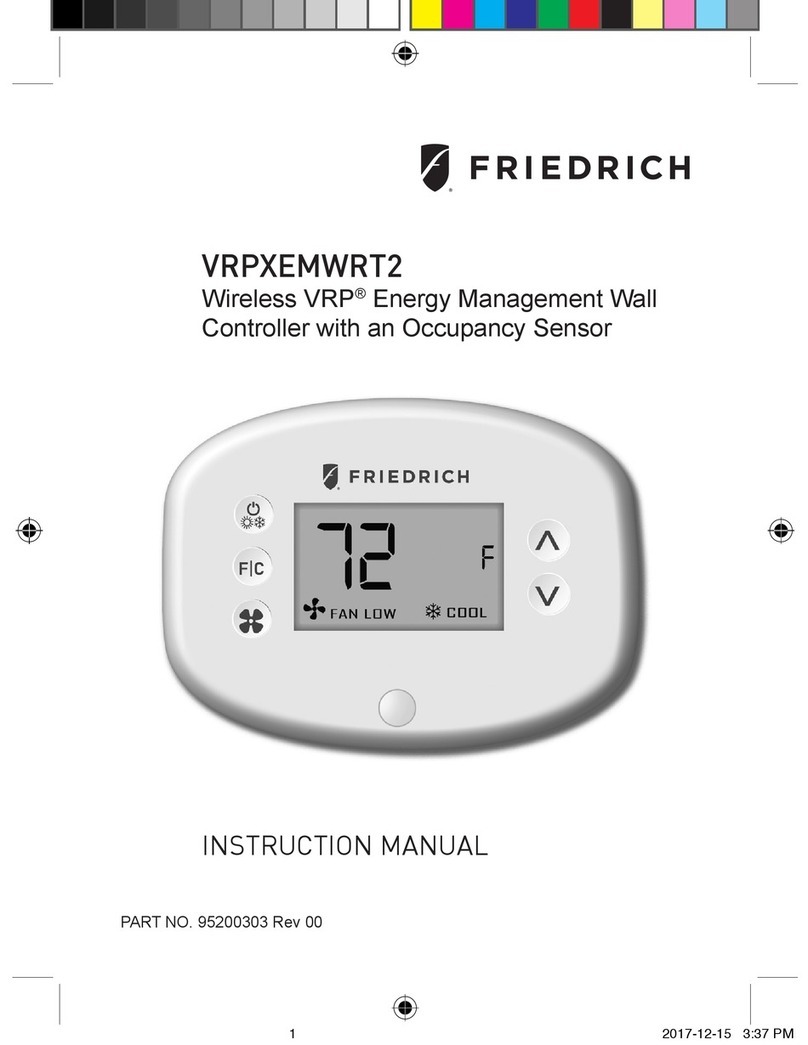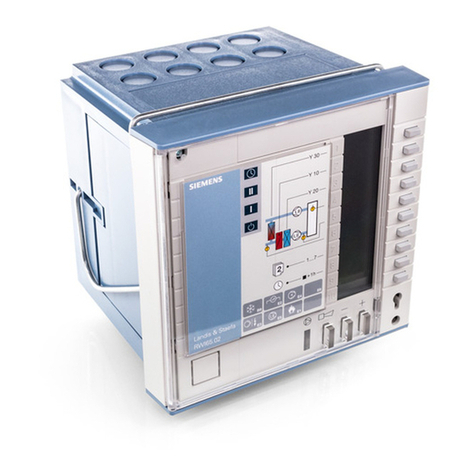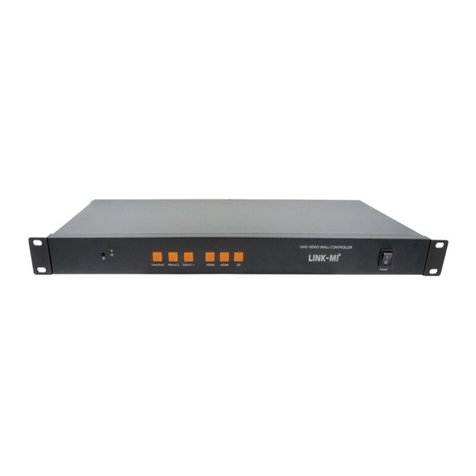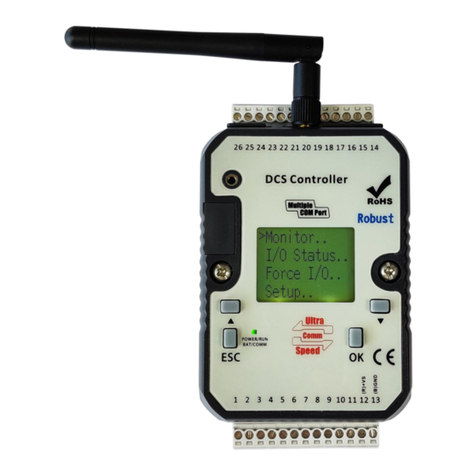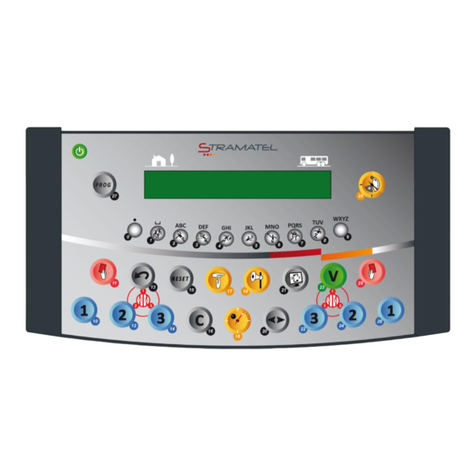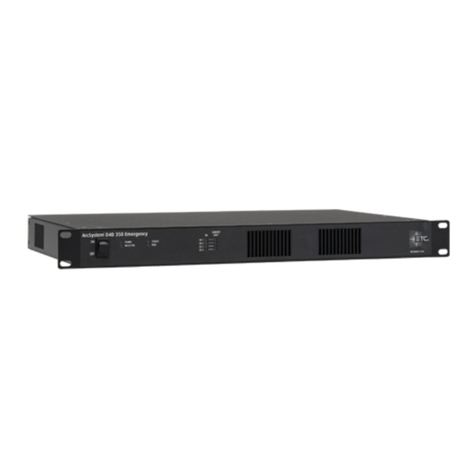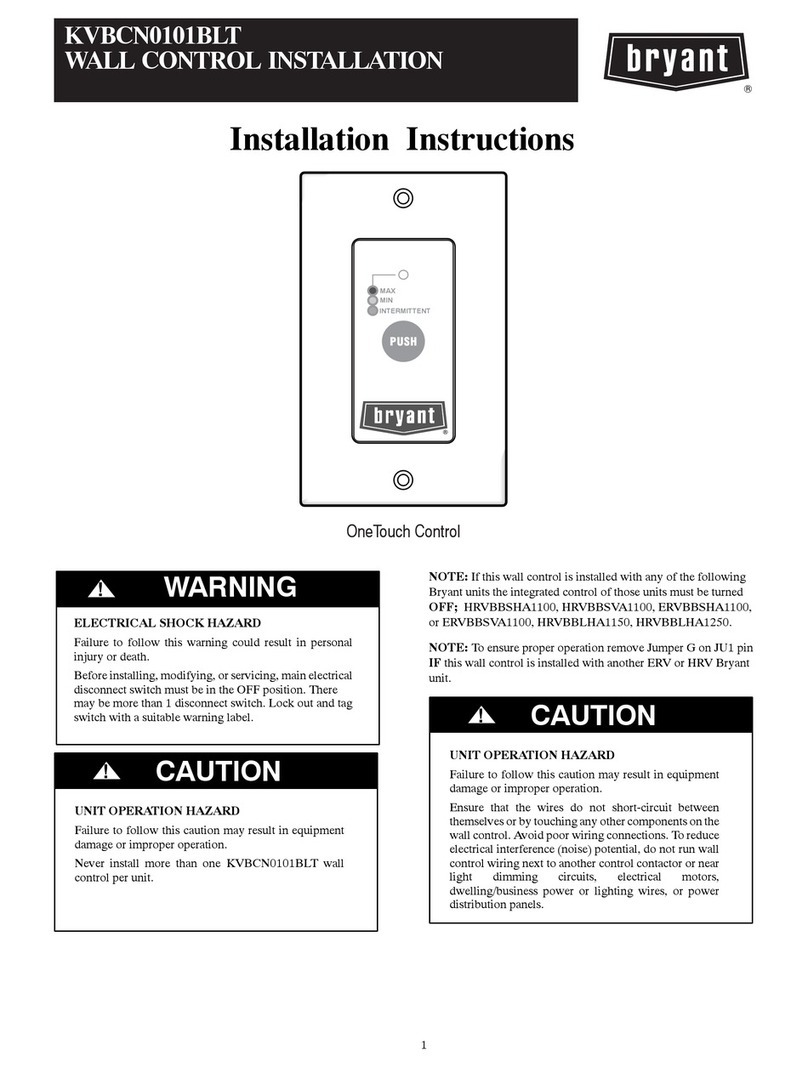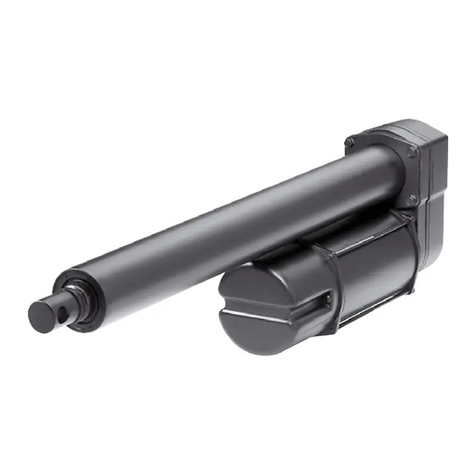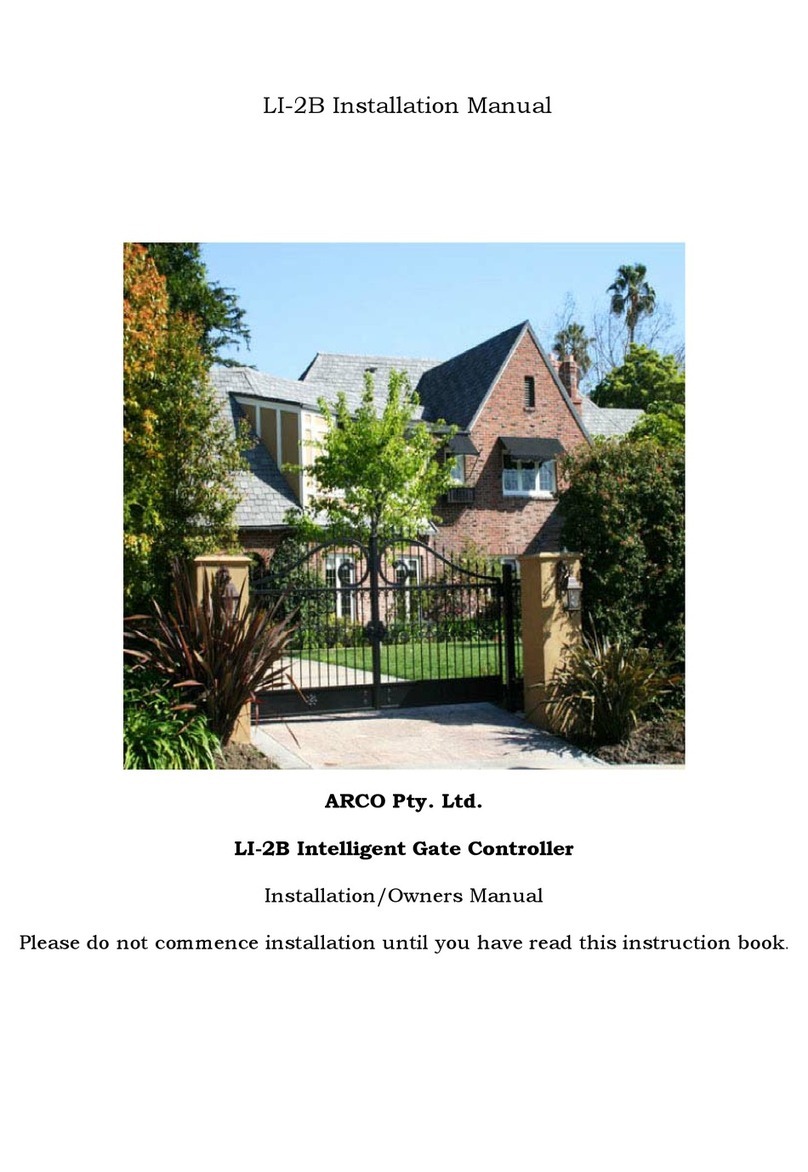TDI T100-V User manual

From Tech Development
6800 Poe Ave. Dayton OH 45414
Tel: (937) 898-9600 Fax: (937) 898-8431
Website: tdi-turbotwin.com
Publication T1-321
Dated: November 15, 2013
INSTALLATION AND OPERATING
MANUAL
MODEL: T100-V
TURBOTWIN Engine Air Starters
P/N: T112-60082-001

TDI TURBOTWIN
FROM TECH DEVELOPMENT
Page: i Publication T1-321
Issued November 15, 2013
TABLE OF CONTENTS
SECTION SUBJECT PAGE
1.0 General Information……………………...1
2.0 Orientation of the Starter…………………2
3.0 Installing the Starter………………………2
4.0 Starter Operation………………………….4
5.0 Starter Removal………………………….. 5
6.0 T100-V Warranty………………………….6
7.0 Troubleshooting Guide………………….. 7
LIST OF ILLUSTRATIONS
FIGURE TITLE PAGE
1 Direction of Rotation…………………….. 2
2 T100-V Envelope Drawing……………... 8
3 T100-V Installation Diagram……………..9
Performance Curves (Air)………………..10

TDI TURBOTWIN
FROM TECH DEVELOPMENT
Publication T1-321 Page 1
Issued November 15, 2013
1.0 GENERAL INFORMATION
This manual provides instructions for the installation and
operation of the TDI T100-V TURBOTWIN Air Starters
P/N: T112-60082-001. If there are questions not
answered in this manual, please contact your TDI
TURBOTWIN distributor or dealer for assistance.
The T100-V starters are turbine driven starters with a
pre-engaged starter drive. The T100-V starters have
applications ranging from 1800 CID (30 Liters) on diesel
engines and up to 18000 CID (300 Liters) on gas
engines. The T100-V models are suited to operate within
a wide range of inlet pressures and ambient
temperatures. The engine size and parasitic loading will
determine the exact minimum pressure that will assure
reliable cranking.
The T100-V starters P/N: T112-60082-001 is designed
for operation with compressed air. Materials used are
compatible with marine environments. Small amounts of
foreign matter or liquid in the air supply will not adversely
affect T100-V starters. As with all TDI starters, no
lubrication is required in the air supply.
Please review the rest of this manual before installing
the T100-V air starter.
WARNINGS, CAUTIONS, AND NOTES
Certain types of information are highlighted in this
manual for your attention:
WARNING - used where injury to personnel or
damage to the equipment is possible.
CAUTION - used where there is the possibility of
damage to the equipment.
NOTE - used to point out special interest
information.
NOTE
Throughout this manual, the term “air” is used to
designate the starter drive medium.
1.1 DESCRIPTION
The T100-V features three basic subassemblies: a
unique two stage turbine motor section, an offset/spur
gear assembly and a pre-engage drive assembly.
The two stage motor section features aerodynamic
speed control. This aerodynamic speed control helps
protect the T100-V starter from damage caused by
starter motor over speed. In addition, a specially
designed motor housing module and low-mass rotors
provide fail-safe operation.
The T100-V employs 9.25:1 ratio spur gearbox. This low
gear ratio allows the turbine motor to spin at low speeds
for long bearing life. At a typical 3000 rpm pinion speed,
the turbine is rotating at a low 27750 rpm.
A reliable pre-engaged drive delivers the torque to the
pinion. The pinion is translated out to engage the
engine's ring gear via the starter’s engagement piston.
Compressed air is used to power the T100-V through the
inlet port. The air is expanded through the first stage
nozzle. The high velocity gas impinges on the first stage
rotor to yield torque to the gearbox through momentum
exchange. The air is further directed through the second
stage stators which impart additional torque to the
second stage rotor.
1.2 PRODUCT IDENTIFICATION
The starter nameplate which is attached to the turbine
housing contains the following information: model
number, serial number, part number, direction of rotation
and the maximum rated operating pressure.
The directions of rotation are either right hand or left
hand rotation as shown in Figure 1. Right Hand rotation
is defined as clockwise rotation as viewed from the
pinion end of the starter, and Left Hand rotation is
counter clockwise rotation viewed from the pinion end of
the starter.

TDI TURBOTWIN
FROM TECH DEVELOPMENT
Page 2 Publication T1-321
Issued November 15, 2013
Figure 1. Direction of Rotation viewed from Pinion End.
The maximum operating pressure identified on the
nameplate is measured at the check port on the starter
inlet with the starter in operation.
CAUTION
Exceeding the maximum pressure shown on the
nameplate may result in drive failure, damage to the
starter, or damage to the engine.
The housing proof pressure is 600 psig and is also
shown on the nameplate. This means that the turbine
housing will not burst when subjected to a static
pressure of 600 psig.
TURBOTWIN starters may not be used in areas that are
subject to explosion hazards under any circumstances.
1.3 PHYSICAL CHARACTERISTICS
Figure 2 shows the configuration for the T100-V P/N:
T112-60082-001 with exhaust screen. This model
weighs approximately 54 lbs. and is 16.8 inches in
length. The turbine housing diameter is 6.8 inches,
which is common to all T100 TURBOTWIN air starters.
WARNING
Suitable hoisting gear must be used for the
transport and installation of the starter. If no hoisting
gear is available, the starter must be lifted from the
packaging by two people. Failure to comply with
this precaution may lead to back injuries. When
transporting the starter, wear suitable safety shoes.
CAUTION
When transporting the starter, wear suitable safety
gloves.
1.4 PERFORMANCE
The performance curve for the T100-V illustrates the
pinion torque versus pinion speed (rpm) at a constant
drive air pressure, and horsepower versus pinion
speed at a constant drive air pressure. The pinion
speed is shown on the horizontal axis while the pinion
torque is shown on the left edge of the vertical axis. Air
consumption rates are given for the various drive
pressures. The drive gas used for the performance
curve is air.
2.0 ORIENTATION OF THE STARTER
If the factory orientation of the starter turbine housing
assembly does not fit your engine installation, this
component can be re-oriented.
Determine the required orientation of the turbine housing
assembly and gearbox housing assembly. The turbine
housing assembly can be rotated to six different
positions relative to the gearbox housing assembly. The
drive assembly can be rotated to twenty four positions
relative to the inlet port.
Orientation of the starter should be accomplished prior to
installing the starter on the engine.
CAUTION
All screw threads are treated at the factory with a
fastener retention compound. Every screw and
tapped hole must be clean with a drop of Loctite 242
applied to the threads before being installed.
3.0 INSTALLING THE STARTER
Confirm the part number T112-60082-001 of the starter
on the nameplate is the one recommended by TDI.
A turbine air starter does not require lubrication in the
supply air. If a vane type starter motor is being replaced,
TDI recommends that all lubrication devices and lines be
removed to minimize flow restrictions.
WARNING
If a fuel (pulse) lubricator has previously been
installed in the system, disconnect and plug the line
to eliminate spraying diesel fuel on the engine.

TDI TURBOTWIN
FROM TECH DEVELOPMENT
Publication T1-321 Page 3
Issued November 15, 2013
The starter should be installed with the inlet valve in a
position between horizontal and straight down. Any
condensation will be restricted to the air lines and not in
the starter.
WARNING
Do not operate this starter unless it is properly
connected to an engine.
Only qualified personnel with the corresponding
professional training may perform pneumatic and
electrical connections to the TURBOTWIN starter.
3.1 SUPPLY LINE INSTALLATION
WARNING
Be sure to either bleed the pressurized air reservoir
and/or safety the system such as closing all valves
prior to installing any starter supply line.
T100-V starters come standard with a flange envelope
and hole pattern accepting SAE code 61 hydraulic flange
for the inlet connection port.The supply line consists of
the line from the air source, a pressure regulator (when
necessary), an integral relay valve P/N: RLVA-60083-
003 with code 61 bolt pattern. A section of flexible tubing
should be installed at the starter to prevent leaks due to
engine vibration.
Care must be taken to ensure that all inlet supply line
piping is no less than 1.5” and that all components used
are capable of passing the required air flow.
NOTE
Valves with a Cv of 40 or higher is recommended.
If the supply line must be longer than 20 feet, the inlet
supply line piping should be increased to 2" in diameter
to ensure proper performance by your TURBOTWIN.
Because turbine starters such as the T100-V are
sensitive to flow restrictions, care must be taken to use
uniform hose or tubing and fittings for connection of the
supply line. Tees, elbows and line length must be kept
to a minimum. TDI recommends that hose or flex
couplings be installed to eliminate possible leakage
caused by strain on the supply line.
Normally, an air strainer is not required. In dirty
environments, use of a #40 mesh Y-strainer is
recommended. The T100-V is highly tolerant of dirt in
the air line, however, starter life can be increased with
the use of an air strainer P/N: 52-93550-200.
A pressure regulator is required when the air supply
pressure is great enough to exceed the starter operating
pressure (at the inlet port).
The supply line should be dry-fitted for proper
alignment/location prior to final assembly. All pipe-
threaded joints should be sealed with Loctite Pipe
Thread Sealant (TDI P/N 9-94085) or equivalent for leak
tight joints prior to final assembly. Be sure to tighten all
joints to proper torque after final assembly.
CAUTION
In cold weather climates, care should be taken while
designing your installation to prevent condensation
from developing in the starter system. In systems
with a regulator or relay valve, there is the possibility
of freeze-ups.
CAUTION
On new installations, it is strongly recommended to
blow out the supply line with air to remove possible
dirt and welding slag prior to final connection to the
TURBOTWIN starter. Be sure to secure the free end
of the supply line prior to blowing out the line.
3.2 INLET PRESSURE PORT
A 1/4" NPT port is located on the air inlet. This port may
be used to check the supply pressure at the starter when
the starter is operating. Remove the 1/4" NPT pipe plug
and save for later use. Install 1/4" minimum size tubing
to the port. Route the tubing away from the starter to a
safe location away from the engine. Install a pressure
gauge on the tubing. This pressure monitoring
line/gauge may be permanently installed. Use Loctite
Pipe Thread Sealant or equivalent. Alternately, a
pressure transducer may be installed at the pressure
check port and electrical lines routed to a digital display
at the operator's station.
This pressure port is invaluable in diagnosing air starter
and/or installation problems.
3.3 EXHAUST PIPING
The turbine exhaust may be plumbed away from the
starter area.
The performance of a turbine starter will be decreased
because of back pressure when smaller than

TDI TURBOTWIN
FROM TECH DEVELOPMENT
Page 4 Publication T1-321
Issued November 15, 2013
recommended exhaust piping is installed. Consult your
TDI distributor for advice.
Exhaust piping should be routed downward to help
prevent any accumulation of condensation in the starter
motor.
If the overhung section of the starter is not otherwise
supported, TDI recommends that the exhaust piping be
supported with a suitable bracket(s).
3.4 SOFT START VALVE & FILTER FITTING
The “soft start” fitting, by providing a slower opening
of the starter relay valve, eliminates excessive starter
pinion gear loading. The soft start fitting is identified by
P/N: 2-28243 found on its body. This fitting MUST be
installed at the starter relay valve as shown in figure 4. It
is screwed into the applied pressure (“IN” or “APP”) port
on the starter relay valve. There are currently no
approved substitutions for this fitting.
The filter fitting provides contamination protection to
the starter’s pre-engagement mechanism and the soft
start fitting installed downstream. The filter fitting is to be
installed on the “IN” port of the starter as shown in figure
4. It appears similar to the soft start fitting, however,
P/N: 2-28270 is found on its body.
CAUTION
For maximum pinion life and full warranty coverage,
the soft start valve (P/N: 2-28243) MUST be installed
in the applied pressure port (APP) of the relay valve.
WARNING
All pipes, fittings, flexible hose assemblies and
electrical harnesses are not to be used as a handle.
The starter is not to be used as a foot step.
Damage to pneumatic circuitry and/or starter can occur if
this warning is not heeded.
3.5 PIPING SYSTEM
Only type approved metallic hose assemblies are
approved in permanently pressurized compressed air
lines of starters. Non-metallic hose assemblies are
allowed only in case the piping system will be emptied
after the starting procedure.
Pipe unions must be type approved by GL. Downstream
of the pressure regulator a pressure relief valve should
be provided.
4.0 STARTER OPERATION
Prior to operation, check that all connections are tight
and free from leaks. Check the 1/4" NPT pipe plug or a
pressure gauge/transducer that may be connected to the
pressure port on the starter inlet.
WARNING
Do not operate the TDI TURBOTWIN starter with air
pressure greater than the pressure rating on the
nameplate. This pressure is measured at the starter
inlet while the starter is running. The TURBOTWIN
starter may only be operated in fully installed
condition.
The maximum operating pressure limit is the inlet
pressure measured at the starter’s inlet pressure check
port. To check the pressure, a 1/4"NPT pipe tap
connection is provided in the inlet housing to attach a
pressure gauge.
The static non-flowing supply pressure will always be
higher than the operating (dynamic) pressure. The
maximum pressure limit (proof pressure) that the T100-V
starter housings may be subjected to is 600 PSIG (42
BAR). System pressure that exceeds the maximum
operating limit must use a pressure reducing device to
ensure that the operating pressure limit to the T100-V
starter is maintained.
System static pressure that exceeds the 600 PSIG (42
BAR) limit must, in addition to pressure reducer devices,
incorporate a pressure relief valve set below 600 PSIG
(42 BAR) in the supply air line downstream of the
pressure regulator.
NOTE
For maximum life of the starter pinion and for the
protection of the engine ring gear, limit the operating
pressure to that necessary to start the engine at its most
difficult starting conditions.
All appropriate local pressure codes and pressure
limitations on other system components must be
adhered to and supersede the guidelines given in this
manual.
CAUTION
The operation of the starter may result in noise levels
exceeding 90 dBA. Protective hearing equipment
must be worn at all times.

TDI TURBOTWIN
FROM TECH DEVELOPMENT
Publication T1-321 Page 5
Issued November 15, 2013
Consult your TDI distributor if you have exhaust
plumbing that creates back pressure and reduces starter
performance.
Follow the engine manufacturer’s instructions for starting
the engine.
CAUTION
The grease used in the planetary system has a shelf
life of 2 years. Therefore, if the starter is NOT
installed and operated on the engine for 2 years
after the starter is manufactured, the grease should
be replaced prior to starter operation. The
manufactured date is reflected in the starter serial
number. (Ex: 0602-0567 has a manufactured date
of February 2006.
4.1 BASIC OPERATION
The basic operation of the starter follows:
Pressurized air is admitted to the starter’s engagement
piston chamber via the “in” control port by opening the
manual or solenoid valve. The air then translates the
starter’s piston forward allowing the pinion to engage the
engine’s ring gear.
NOTE
40 psi minimum pressure applied to the pre-engaged
piston is required to engage the pinion into the ring.
The forward movement of the piston causes the starter’s
“out” control port to open. Air is then transmitted to the
applied pressure port (APP) on the relay valve causing
the relay valve to open.
Pressurized air is admitted to the starter’s turbine
assembly by the opening of the relay valve. The air
expands through the turbine which produces shaft
rotation and torque. The starter motor torque causes the
engine to accelerate. The fuel and ignition systems now
fire the engine. Closing the relay valve stops the starter.
The operator may decrease starter life by the continual
operation of the starter after the engine has started. After
a successful engine start, turn the air off to the starter
immediately. Minimizing the time the starter is operating
unloaded will maximize starter life. If a start is aborted, a
restart may be attempted after the engine and the starter
have come to rest.
CAUTION
Do not engage the starter while the engine is
running.
The drive air pressure is the primary starter control
parameter. It is important, especially on new
installations, to measure this pressure during several
engine starts.
The secondary parameter is the starter pinion speed.
This speed is usually measured by knowledge of the
engine starting speed and the starter cranking ratio. The
cranking ratio is the number of ring
gear teeth divided by the number of pinion teeth. The
starter pinion speed is then found by multiplying the
engine speed by the cranking ratio. The pinion speed is
usually 2000-3500 rpm at typical engine starting speed.
P/N: T112-60082-001 is configured with 15 teeth.
4.2 AUTOMATED START PANEL
The starter drive pressure measured at the starter inlet
will need to be set. As noted above, for maximum life of
the starter pinion and for the protection of the engine ring
gear, limit the operating pressure to that necessary to
start the engine at its most difficult starting conditions.
The speed control parameter will then need to be set.
Engine starting speed along with the cranking ratio
number can be used to determine starter pinion speed.
The pinion speed is usually 2000-3500 rpm for a typical
engine starting speed. Once the start sequence has
begun, the air is admitted to the starter. The starter
begins to accelerate the engine. Once the firing speed of
the engine is reached, the automated start panel may
deliver fuel to the engine. The engine will begin to
accelerate under its own power. The starter should be
dropped out of the sequence at an rpm higher than the
firing speed, but less than the engine idle speed.
The automated start panel should monitor engine speed
to set air on and air off. Do not simply use time as a
control parameter. Avoiding excessive operation of the
starter after the engine is firing will maximize the starter
life.
5.0 STARTER REMOVAL
WARNING
Be sure to bleed pressurized air from reservoir and/or
safety the system by closing the upstream valve to the
starter before starter removal.

TDI TURBOTWIN
FROM TECH DEVELOPMENT
Page 6 Publication T1-321
Issued November 15, 2013
6.0 WARRANTY
Tech Development (TDI) warrants to the original user of the TDI TURBOTWIN™ air starters to be free from defects in
material and workmanship for a period of one year from the date of installation. The warranty period shall not extend
beyond two years from the date the unit was manufactured. (i.e.: a unit with a manufactured date of July 1999 (SN: 9907-
0101) will not be covered under warranty after July 2001). The conditions of this warranty are: a) TDI is notified within
this period by return of such product to TDI or its authorized distributor/dealer, transportation prepaid by user; b) the
starter has been installed according to TDI’s specifications; c) the starter has not been misused, abused, or improperly
maintained by user; d) the defect is not the result of normal wear and tear; e) the starter has been repaired with parts
manufactured or authorized by TDI; and f) TDI installation and repair procedures as outlined in the appropriate manual
were properly followed.
Tech Development will repair, or at its option, replace the unit during the warranty period at no charge to the customer,
provided it is returned to TDI with the proper return procedures.
Tech Development makes no other warranty, and implied warranties including any warranty or merchantability or fitness
for a particular purpose are hereby disclaimed.
This warranty constitutes the entire obligation of Tech Development relating to the sale and use of such product, and
TDI’s maximum liability is limited to the purchase price of such product at the date of purchase. In no event shall TDI be
liable for incidental, indirect, consequential, or special damages of any nature arising from the sale or use of such engine
starter product.

TDI TURBOTWIN
FROM TECH DEVELOPMENT
Publication T1-321 Page 7
Issued November 15, 2013
7.0 OPERATOR’S TROUBLESHOOTING GUIDE
TROUBLE PROBABLE CAUSE SOLUTION
1. Air always flows through
exhaust A. Relay valve improperly
installed. A. Check typical installation
diagram and correct.
B. Relay valve not sealing
properly. B. Check for damaged sealing
ring, replace relay valve or
damaged parts.
C. Solenoid is not sealing,
pressure remains in APP port of
relay valve.
C. Check solenoid potential at the
lead to ground should be 0. If not,
fix ignition switch problem.
2. Starter engages but does not
run, A. Bad relay valve A. Replace relay valve.
3. Starter does not run, small air
flow from turbine exhaust or
drive housing.
A. Nozzle blockage. A. Remove blockage or obstruction
from nozzles.
4. Starter does not run. Normal
air flow from exhaust. A. Excessive bends in the
supply line. A. Shorten length or straighten
supply air line.
5. Pinion does not engage A. Air pressure is too low A. Increase air pressure to 40 -
150 psig.
B. Control lines to starter ports
reversed. B. Check installation diagram and
correct.
C. Solenoid valve not operating
or plugged. C. Check wiring and solenoid
operation. Correct wiring, remove
blockage, or replace solenoid
valve as needed.
D. Damaged pinion teeth. D. Replace pinion or starter drive
as necessary.
6. Starter runs but engine cranks
slowly or not at all. A. Air pressure too low A. Increase air pressure to 40 –
150 psig.
B. Excessive back pressure. B. Check Exhaust
C. Nozzle blocked or damaged. C. Remove blockage or replace
damaged parts.
7. Starter continues to operate
after start button is released. A. Solenoid valve is not sealing
correctly. A. See 1C above
B. Relay valve is not sealing
correctly. B. See 1B above
8. Air tank pressure decays after
extended shut down. A. Air connections are not tight. A. Tighten loose fittings. Repair or
replace damaged fittings.
B. Damaged air lines: crushed,
frayed, and kinked. B. Replace damaged lines.
C. Relay valve is not sealing
correctly. C. See 1B above
D. Solenoid valve is stuck open. D. A. See 1C above

TDI TURBOTWIN
FROM TECH DEVELOPMENT
Page 8 Publication T1-321
Issued November 15, 2013
Fi
g
ure 2. T100-V Envelo
p
e Drawin
g
for P/N: T112-60082-001

TDI TURBOTWIN
FROM TECH DEVELOPMENT
Publication T1-321 Page 9
Issued November 15, 2013
Fi
g
ure 3. T100-V Installation Dia
g
ram for P
/
N: T112-60082-001

TDI TURBOTWIN
FROM TECH DEVELOPMENT
Page 10 Publication T1-321
Issued November 15, 2013
Other manuals for T100-V
1
This manual suits for next models
1
Table of contents
Other TDI Controllers manuals


